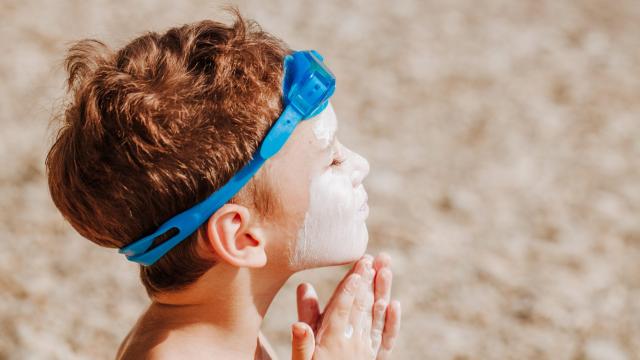The tricky thing about sunscreen is that, if applied properly, it’s invisible. So how can we tell when enough of an invisible thing is enough? In general, we can probably start with the assumption that the amount we’re applying isn’t enough — because, according to the American Academy of Dermatology, most people only apply 25-50 per cent of the recommended amount.
Even when you’re applying sunscreen on yourself — a willing and able adult — you’re likely not using enough. (For an average adult, the AAD defines “enough” as about 30mL, enough to fill a shot glass, to properly cover any skin not already covered by clothing.) Kids won’t need quite that much, but when you add a squirming, impatient young child into the equation, you’re probably tempted to declare “good enough” a bit too soon.
Let’s talk about creams, gels, sticks, and sprays
To make sure they’re getting the best coverage possible, you’ll first want to consider using the best type of sunscreen for the situation and body part. Sunscreens generally fall into four categories: creams, gels, sticks, and sprays. Creams are best for (dry) skin and faces; gels are good for hairy areas, such as the scalp; sticks are good for around the eyes, and sprays can be an easy solution for parents — with some caveats.
Parents often prefer spray sunscreens because they’re the quickest and easiest to apply; however, it can be especially challenging with spray to know whether you’ve applied enough or covered all of the skin. Sprays should not be inhaled, and some of them are flammable and shouldn’t be applied near heat, an open flame, or while smoking. For those reasons, it may not seem like the best option, but as Lifehacker’s senior health editor points out, the best sunscreen is the one you’ll wear.
So if a spray is the best way to get the kids the most decent coverage, go for it — just don’t spray it directly on their face (spray it into your hand and then apply it to their face). Spray more than you think you need, and then rub it in for more even coverage, taking care that the wind doesn’t blow it into their face.
How much sunscreen should your kid wear, and how often?
You’ll want a sunscreen that has at least an SPF of 30, offers broad-spectrum protection (i.e., protects against UVA and UVB rays), and is water-resistant if water will be a factor. Whenever possible, aim to apply it 15 minutes before they’ll be out in the sun — here are our best tips for applying sunscreen without a major battle.
Once they’re outside playing, you’ll want to reapply every two hours or after swimming or sweating, whichever comes first, even on cloudy days. Using a higher SPF is also great, as it will block slightly more UVB rays, but don’t let it lull you into a false sense of security — a higher SPF doesn’t last longer than a lower SPF, so you’ll need to reapply just as often.
And all of this goes for kids over the age of six months old — parents should avoid exposing babies under six months to the sun’s rays entirely.
Don’t forget the problem areas
There are a few spots we tend to overlook when we’re trying to sunscreen our kids up as efficiently as possible, but it’s important to hit them all: The tops of the feet and hands, the ears, the back of the neck, the top of the head, and lips all need some attention. (You can use a lip balm with an SPF 30 or higher.)
KidsHealth also recommends applying sunscreen under any swimsuit straps, in case they shift while the child is playing. Remember that all kids, regardless of skin tone, can get painful sunburns without the protection and need to wear sunscreen.
And finally, one of the best ways to earn their compliance is by modelling all these good habits with your own skin.

Leave a Reply
You must be logged in to post a comment.